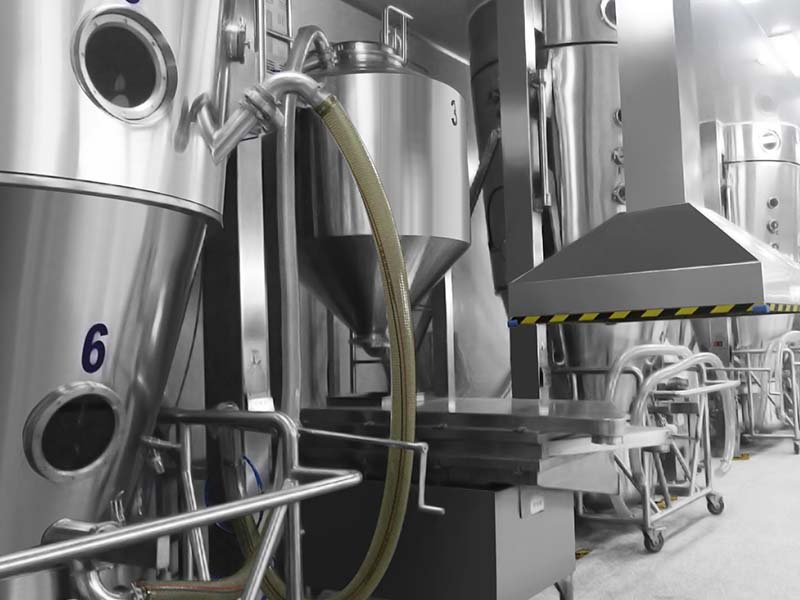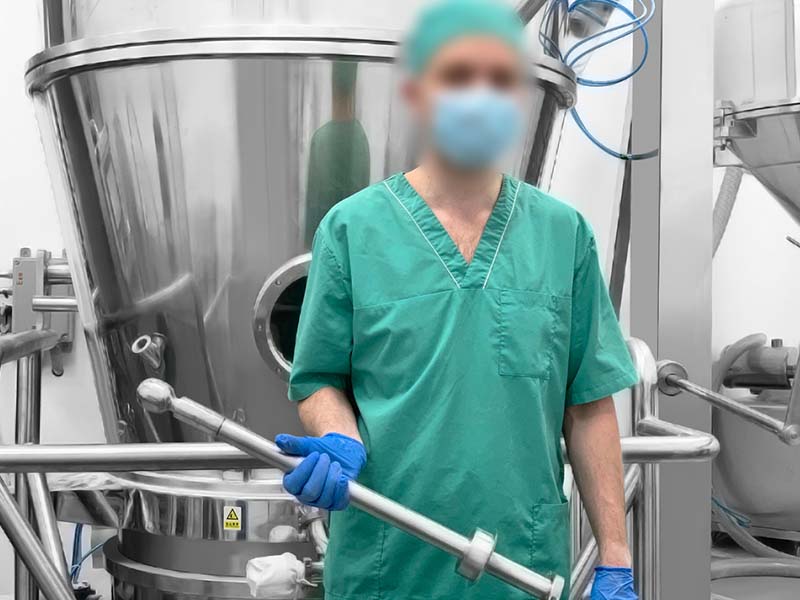Key Points Of This Chapter
The basic principle of drying, the advantages of fluidized bed drying compared to box drying: high efficiency, large load capacity, less manual intervention, and short time.
Fluidized bed drying includes short preheating stage, constant speed stage and speed reduction stage. In order to maintain good drying effect and high efficiency, it is necessary to effectively monitor the inlet air temperature and humidity, material temperature and exhaust temperature, as well as the inlet air volume, etc.
This chapter explains the challenges faced by fluidized bed drying from different aspects, such as: loading method of wet materials, particle size control of dry materials, fluidized drying of viscous materials, drying and crushing of particles, uniformity of drying, etc.
Fluidized bed drying is a continuous process, and the biggest challenge is the confirmation of the drying end point. This chapter lists several end point confirmation methods, which can be selected according to product characteristics.

Chapter 6 Drying
01 Theory
Drying in this chapter refers to the removal of water or other solvents from granulated products through a fluidized bed at specified temperatures and humidity.
During the fluidized bed granulation process, liquid spraying and solvent evaporation occur simultaneously. When the adhesive spray is stopped, drying of the particles continues until unbound moisture has evaporated. Drying ends when surface moisture is replaced by diffusion, from the center of the particle through the capillary, causing the product temperature to rise. For products granulated in the chamber, the drying sequence is similar to the product drying stages in a fluidized bed.
The fluidized bed drying process is divided into three stages, including a short preheating stage, a constant speed stage and a speed reduction stage. The constant rate stage corresponds to a constant bed temperature, and the material is dried in the suspended upward moving air. The ability of the air (gas) to absorb and carry away moisture determines the drying rate and determines the duration of the drying cycle. Unbound water is easily lost by evaporation until the equilibrium moisture content (EMC) of the solid is reached. Once the solid reaches its equilibrium moisture content, extending the drying time will not change the moisture content because equilibrium has already been reached. The higher the temperature of dry air, the greater its saturated water-holding capacity. However, the maximum dry air temperature will be determined by the heat sensitivity and thermoplasticity of the product. As with heat transfer, the maximum mass transfer rate that occurs during drying is directly proportional to the surface area, turbulence of the drying air, the driving force between the solids and the air, and the drying rate. Since the temperature of wet particles in hot air determines the evaporation rate, the key to analyzing the drying process is the measurement of humidity.
Fluidized bed drying offers significant advantages over traditional tray drying used in the pharmaceutical industry. These advantages include:
1) Increase drying efficiency and product loading capacity while significantly improving thermal efficiency.
2) Increase the drying capacity per unit area.
3) Improve the ability to control product temperature during the drying process to facilitate the handling of heat-sensitive materials.
4) Simplify loading and unloading operations and reduce loading and unloading costs.
02 Dry Granular Products
Products granulated at high shear can be dried using tray dryers or fluidized beds. To increase and optimize process efficiency, fluidized bed drying is preferred. During the drying process, the inlet air temperature and humidity, material temperature and exhaust temperature, as well as the inlet air volume, are continuously monitored. In particular, the feed temperature and exhaust temperature indicate a constant rate and a decreasing rate during the drying period.
03 Challenges Faced By Fluidized Bed Drying
1) Loading Of Wet Materials
There are two ways to load wet granules into the loading chamber. First, manual transfer into the fluidized bed. Second, the wet particles are delivered pneumatically directly to the fluidized bed, which is usually done in an integrated system setup.
2) Influence Of Particle Size
To dry granular products, it is recommended to pass the wet material through a coarse sieve, which subdivides the sticky clumps of product into free-flowing granules. This creates a larger surface area available for drying, resulting in faster drying and a more efficient process. This also minimizes particle “case hardening”, where the outer surface of the particle dries but the center of the particle remains wet, creating further processing issues.

3) Reduce Particle Breakage
During fluidized bed processing, due to severe fluidization, collisions between particles and particles and the container wall will occur. During the drying process, the crushing and abrasion of particles will reduce the particle size of the product, produce fine powder and affect the fluidity of the dried product. In practice, crushing or abrasion is an important factor in the formation of fine powders, and it affects the flowability of granular materials. This breakage depends on the strength of the granules formed, which in turn reflects the amount and type of binder used in the granulation process. Generally, reducing the fluidization speed during the drying stage will help reduce the production of fines. Particles may exhibit an inherent tendency to break during drying, depending on the moisture content, binder type and degree of stress to which the particles are exposed.
4) Fluidization Of Viscous Materials
When drying viscous materials in a fluidized bed, the interparticle forces are considerable and they seriously affect the flow behavior of the bed. During the fluidization process, the bed breaks into large pieces and gases tend to flow into the gaps between the fractures. Then, channeling occurs in the bed, and eventually, the gas-solid contact is very low and heat and mass transfer are weakened. For example, sticky granules from a centrifugal granulator are sometimes difficult to fluidize with process air alone. It may be necessary to provide a mechanical rake in the product carousel to disperse the viscous material with mechanical energy until the fluidizing air is able to fluidize the material. In some cases, the airflow distributor may need to be replaced. At a given air volume, a restrictive distributor will provide a higher fluidization velocity to promote fluidization of the product. Another option is to pass the viscous material through a granulator before feeding it into the fluidized bed processor. The integrated system discussed in Chapter 12 may be helpful in understanding how the product is transferred from the mixer through the granulator to the operating fluidized bed.
5) Reduce Product Segregation
During the drying process, segregation of the already granulated product depends on the physical properties of the ingredients, such as solubility, particle size, density, flowability, solvent type, and the strength and amount of the binder. The nature of the major components will have an impact on whether separation occurs. During the drying process, the combination of granulation solvent and drying conditions may cause some products to convert into alternating crystalline forms.
6) Avoid Uneven Drying
Inefficient or poorly controlled drying processes will result in uneven product quality. This may occur if the particle size, binder solvent, density, and particle size of the dried particles change. This can also be caused by uneven fluidization rates due to fines clogging the airflow distributor or lack of proper cleaning. Mismatched airflow distributors can be another cause of uneven fluidization. Too fast speed, that is, the exhaust air temperature rises rapidly, will not only lead to uneven drying of the product, but also lead to low process efficiency.
7) Dry Non-Aqueous Granulation
In situations where flammable solvent granulation is required, process air and nozzle atomization air are replaced by inert gases such as nitrogen, and the system is designed as a closed cycle with solvent recovery capabilities. When drying solvents, common practice is to adjust the air intake to keep the solvent vapors in the exhaust stream below the lower explosive limit (LEL) and to use a thermal oxidizer to burn the solvent vapors in the exhaust gases. Generally, organic solvents produce smaller particles than aqueous solvent granulation due to their rapid evaporation from the process. Care must be taken to utilize sufficient airflow to overcome the lower explosive limits of the solvent. Aqueous solvent drying is very different from organic solvent drying. The combined effects of low vapor pressure, high heat of vaporization and inlet air humidity make aqueous drying more difficult than drying non-aqueous products.
8) Shorten Drying Time And Improve Efficiency
Increasing the inlet air temperature can improve drying efficiency and shorten process time, because high temperatures have higher saturated moisture content. For larger batch sizes, higher inlet air temperatures are beneficial against higher batch weights. Higher weights may lead to compaction of porous particles. The higher the temperature, the more porous the particles and the shorter the drying time. It is reported that using a higher inlet air temperature can increase the evaporation rate; when the inlet air temperature increases from 90°C to 120°C and the fixed air volume is 4000scfm, the evaporation rate increases from 56g/s to 78g/s. The increase in particle diameter reduces the available surface area of the particles, resulting in a lower drying rate for coarse particles than for fine particles; therefore, it is highly recommended to sizing the material through a coarse granulator before drying. The humidity of the incoming air affects the drying speed of water-based particles. Research shows that an increase in the humidity of the incoming air causes an increase in product temperature. During the liquid addition stage, when the absolute inlet air humidity increased from 4.5g/m3 to 23.4g/m3, the powder bed temperature increased linearly by 10°C.
9) Increase Production
Depending on the particle size of the final product, which may be a result of abrasion, brittleness of the particles and filter porosity, dry product yield may be reduced by 3%-5%. In addition to using a stable formula during the granulation stage, in order to reduce particle breakage, the following options should be considered: reducing the fluidization air volume at the end of the drying cycle, selecting a collection bag or filter with appropriate filtration accuracy, and selecting a suitable air flow distributor. In the case of products produced in multiple batches, the first batch produced may have lower yields than subsequent batches produced.










